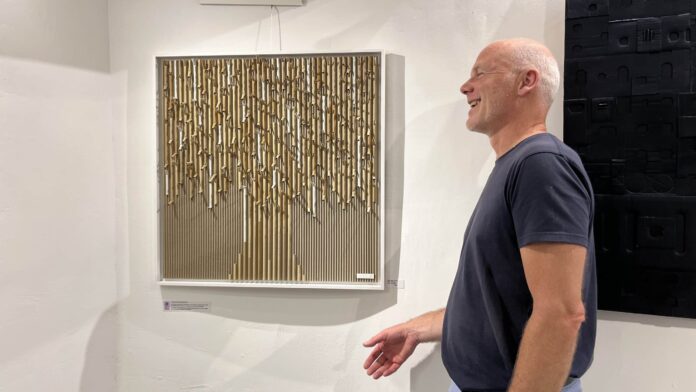Until June 22, Laurent Lecuelle exhibits his works made of cardboard at the Galerie Ferrero, in the heart of Old Nice. Under his pseudonym “ARTON”, the artist reinvents cardboard in the service of art.
In the heart of rue Droite, Laurent Lecuelle stands in front of his works. The artist passionately presents his creations and conveys his unique passion. Paintings, with pieces of cardboard, glued together. Nothing deeper. He tells the story of this material, playing with relief, light, and shapes. Often considered just packaging, in ARTON’s works, cardboard is indeed the finish. Interview.
Why did you choose to create works with cardboard?
Laurent Lecuelle: “Cardboard, it’s in the spirit of the times. I love cardboard, I love talking about the cardboard tool. It passes from hand to hand. It evokes human and commercial flows. It also represents our consumer society. And cardboard has marks: holes, tears. With cardboard, you can do many different things. Paintings with just holes, with torn elements, relief. The paintings represent different things that speak to everyone. What interests me is telling what cardboard symbolizes.”
When did this desire emerge in you?
The trigger was a man from the region: Bernar Venet. In the 1970s, he worked with cardboard and tar. I saw a retrospective of his life and work, and it intrigued me. I went home and started working with cardboard. Then the following week, I went to see an exhibition by Pierre Soulages. It reminded me of the few days before when I was smearing my cardboard. I was struck by its corrugations, which I had painted. I then said to myself that cardboard was interesting and that I was going to explore it further. I did that for two, three years before Covid. I accelerated the creation after coming out of the crisis, then I rented a room to observe people’s reactions. It was immediately well-received.”
And where do you find this cardboard?
When I do my shopping, for example, in a supermarket, I look at the pallets and if someone is tearing up their cardboard, I ask to take some. I then show what I make and they tell me to take what I want (laughs). Also, in front of the stores when they take out their cardboard.
Tell us about the genesis of your works. Do you have an idea of how you’re going to assemble your elements or do you let your imagination run free?
Sometimes I let my imagination run free, but I also like order. I like it when it’s neatly arranged. However, I have a slightly childish side, there must be some freedom after all.
Ordered and disordered at the same time?
That’s correct. And that’s what characterizes me. Maybe that’s what people like about my work. Going in any direction, yet if you look closely, there’s order at some point. There’s a mirror effect. You find similar pieces of cardboard arranged symmetrically. Thanks to this, there’s a harmony that the eye detects, and it makes the viewer feel good with the artwork. There’s a significant technical effort to ensure there’s no imbalance.
And why the choice of monochrome for your works?
I prefer monochrome because it reveals my true work. My true work is underneath, the cardboard. With paint, I’m almost in decoration. When you put too much color, you’re attracted to the color and less to the background. People pass by and tell me “your painting with the color dots is beautiful.” Without mentioning the background, the construction underneath.
On average, how long does it take you to make a painting?
It takes me a day to collect my pieces of cardboard. A day to imagine how to position them and rework them if needed. And I spend a day, or even two, gluing. Then the finishes with the frame, the two coats of paint. The painting is completed in a week.
Is there an ecological aspect to your works?
Yes. There’s a message, of course. What’s fascinating to me is that cardboard is wood. This work with the tree, for example, embodies that. We’re purely in wood. This painting was for a salon with “the tree in all its states” as a theme. It’s a clear message, but my activism is discreet.
Have you ever thought about working with something other than cardboard?
Yes! I have an exception over there. It’s a painting that’s not made of cardboard. It’s leather. I was offended by someone who told me that one of my paintings would have been better in leather. So I went home and searched for some leather. And I enjoyed making this painting because it has a real connection with my cardboard works. You also find cutouts, for example. The fur reflects light differently, so it’s very interesting. I found many common points with cardboard, so I decided I would make more. I’m always on the lookout to find other materials that will make a small exception in my cardboard exhibitions. By adhering to my principles and telling a story. But I want to remain the man of cardboard.
And if you had to define yourself in one word?
Sharing. Because when I make a painting, in the final stages of creating it, it no longer belongs to me. I’m already making it for someone. And I think about the pleasure these people will have from having my painting in their home.
Finally, let’s project a little. Is there a city, a place, in particular, where you’d like to exhibit your works?
Beaubourg (the Centre Pompidou, ed.), or MoMA. Paris and New York. But well, that’s still far away.


